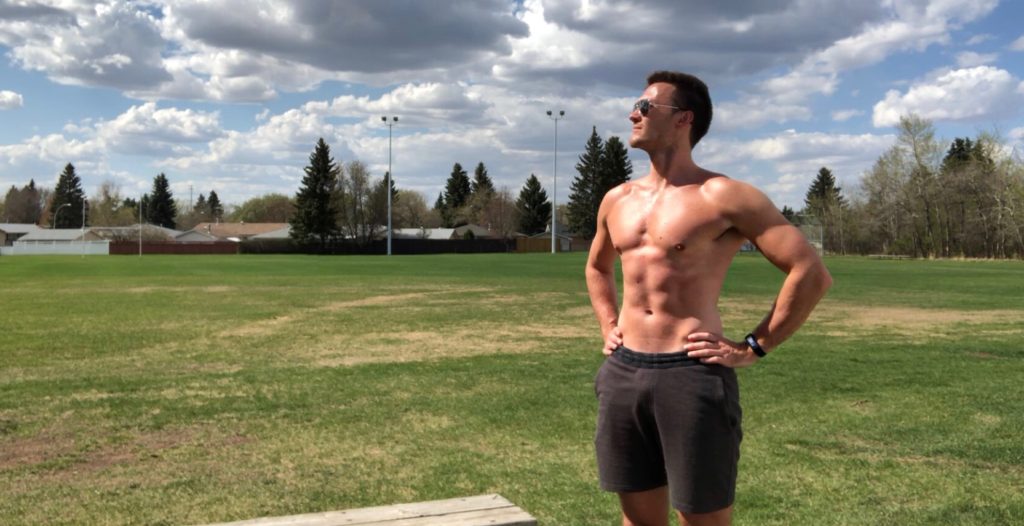Blog
Here are some blog posts about anything fitness related! We cover topics such as weight loss, muscle hypertrophy, strength training, sports performance, nutrition, and anything in between.
Blog
 References
Position of the American dietetic association, dietitians of Canada, and the American college of sports medicine: nutrition and athletic performance (2000). Journal of the American Dietetic Association, 100(12), 1543-1556.
Nutritional concerns for the child and adolescent competitor (2004). Nutrition, 20(7-8), 620-631.
References
Position of the American dietetic association, dietitians of Canada, and the American college of sports medicine: nutrition and athletic performance (2000). Journal of the American Dietetic Association, 100(12), 1543-1556.
Nutritional concerns for the child and adolescent competitor (2004). Nutrition, 20(7-8), 620-631.
When doing any form of physical activity, having proper technique for the exercise at hand is imperative. My whole profession as a personal trainer is based on helping people exercise with proper form and to ensure they are exercising correctly; but why is it so important?
Proper technique has a multitude of functions, all designed to make sure you get the most out of your workouts. There are 4 specific reasons for making sure you are performing all exercises correctly, no matter what exercises they are – jogging, jumping hurdles, squatting, swinging a golf club, and the list goes on!
First and foremost, proper technique is important to ensure that you are efficiently utilizing the exercise at hand to get the desired result. The whole idea of performing a certain exercise is to work towards the result intended; you want to drive the ball the farthest, or run comfortably with no foot or hip pain while maintaining a decent cadence, or focus on building up certain muscles. When performing a barbell bench press, you want to make certain that you are actually working your pectorals and not accidentally using other muscles (like the shoulders). Proper technique allows you to hone in on moving the correct body parts at the correct time to get the correct result.
Secondly, it’s about making sure that there is muscle balance. When performing certain exercises, such as a barbell squat, proper technique is needed to work both (or all) sides of the body equally. The body needs to be oriented in the proper way throughout the movement of the exercise to ensure that there is not overactivation on one side and underactivation on the other side. Equal muscle balance throughout the body not only gives the visually appealing aesthetic look of having a symmetrical body, but also ensures that all parts of the body are being utilized and are physically able to handle loads put on them.
Along with muscle balance comes proper neuromuscular integration. But what does that mean? When we exercise, our bodies obviously adapt so that we can handle the stresses we put on it. Some adaptations we see, such as bigger muscles or a smaller waist, but some we don’t. Before our body can visibly change, our body needs to adapt internally by strengthening the neurological signalling between the central nervous system and the muscles that are being activated. Proper technique allows the body to not only strengthen these neuromuscular connections, but to also make the right connections as well. If proper technique is not followed, incorrect integration will occur, which will hinder how muscles develop.
Lastly, and arguably most importantly, it’s all about safety! Proper technique ensures that you are exercising in the safest environment possible while still working towards your goals. Correct form is based on having stability and control throughout the movement, thus ensuring a safe transfer of weight with minimal chance of injury.
When exercising, make sure to think critically about an exercise before performing it; understanding the mechanics behind why you do an exercise the way you do will help you get the most out of it.
Taking the first step towards creating a healthy lifestyle is always the hardest. It takes a lot of determination and motivation to want to make that change in the first place, and some confidence to actually start on your healthy path. However, it’s always smooth sailing once you’ve made your new health and fitness journey a habit. Sure, you may see some progress towards your goals fairly quickly, but the improvements don’t always come as quickly and consistently as they do right off the bat.
Reaching and surpassing goals is always a great motivator. But it is important to maintain your motivation and internal drive during the progression towards a goal because this is the time when the results may not seem as evident, but your hard work is not going in vain! We’ve all been at that point where you aren’t seeing the results you want to see, and the effort you’re putting in does not seem to be going anywhere. It causes you to lose interest in what you’re doing and can sometimes lead to a relapse of old unhealthy habits.
Here are a few “tricks” you can use to maintain your motivation:
1 Rediscover your goals
When progress isn’t being made (or isn’t evidently seen), the fact that you’re not changing becomes the focus. It’s always a good idea to rediscover the goals that you are set on accomplishing. Change your focus from the day-to-day to the bigger picture, and remind yourself that reaching goals does not happen overnight.
2 Re-evaluate your goals
Rediscovering your goals helps to remind you what you’re working towards. But what if after reminding yourself of you goals you find that you’re not progressing anymore because your goals are either already accomplished or your goals have changed? Re-evaluating your goals is not a bad thing – people change all the time, and you may find that since starting a health and fitness journey that you want to work towards something different than your initial goal. Set yourself straight, update your goals, and set a new path to make sure you are working towards achieving these goals. This readjustment can rekindle the fire inside and encourage you to keep pushing.
3 Always remember how far you’ve come
Looking to the future gives you something to work towards, but don’t sell yourself short on everything that you’ve accomplished up to this point! Take a minute to see how far you’ve come from the start and to remember the progress you’ve made. It took a lot of hard work to get where you are now, and it’s going to take a lot of hard work to keep moving forward, but it’s good to remember that you’re well on your way.
Maintaining motivation is very important, but it is also important to keep yourself accountable for your decisions. Track your progress, know your habits (both good and bad), and know what needs to be maintained and what needs to be changed. If you’re not seeing the results you want to see, take a look at your lifestyle and exercise regime and see if anything needs to be updated. You’re in the driver seat, and you must take responsibility for your actions.
That doesn’t always mean owning up to your flaws and faults, though! Taking responsibility for your actions also means being proud of your victories. Obviously reaching a long term goal is a huge victory, but don’t forget to celebrate the small victories (or as my one client likes to call them, her NSVs – non-scale victories). Hitting new PBs (personal bests) in the gym, running that extra km, besting your last time, or getting that confident feeling when you go shopping and you’re able to git the next size up or down – all of these are small victories that should never be forgotten. Reaching a long term goal takes a lot of time and energy, but celebrating the small steps is just as important.
Everyone wants that body that they can flaunt on the beach – toned back, sculpted arms, and of course, the elusive six-pack. Now, everyone has of course heard that abs are made in the kitchen, and they’re not wrong! A good diet will help reduce body fat so that the abs can show, but a good ab exercise program will help to build those ab muscles so they pop out, giving that great toned tummy look.

When doing an ab program, it is best to work all parts of your torso, not just the rectus abdominus (the actual six-pack). There are a lot of other muscles in your core that can be strengthened to add to that overall strong core look. The internal and external obliques are beside the rectus abdominus and help pull the sides in and keep your body tight, and your transversus abdominus is below the obliques, which gives that “V” shape to your lower torso. When doing an ab circuit, it is best to incorporate exercises for all the muscles of the core, but to also switch up which muscles are being worked as you go so each muscle gets some minor recovery time between exercises. Go through a cycle of exercises that focuses on the rectus abdominus, obliques, and transversus, then repeat that cycle with more exercises.
The best part about ab exercises is that there are a lot of ways to manipulate the body, and you can do a bunch of exercises using just your body. This means you can do a good ab workout virtually anywhere, giving you the convenience to do it wherever you are (and means there’s no excuses not to!). There are tons of exercises that can be done, which gives you the opportunity to easily interchange exercises that still focus on the same muscles, giving your ab program new life and keeping you interested in it. It also doesn’t have to take long; a good ab circuit can deliver a serious burn in mere minutes, leading to great results.
If you need a good ab program to get that beach-ready core, then check out my free downloadable 10 Minute Program for Six Pack Abs! It is designed for any ability, and has different levels of intensity so you can work up to the advanced level.
If you would like more info on ab exercises or different ab programs, feel free to leave a comment or email me directly at sksugden@suggyfitness.com.
To reach your goals, you need to make sure to not only put effort into your workouts, but also into your diet. I’m sure you’ve heard people say that your progress is 30% due to exercise and 70% due to diet, and it’s true! What you put in your body can affect every other part of your life, including your workouts.
Most people always want that quick fix – that magic diet that gives you the results you want in the time you want them, without having to actually sacrifice anything. Well, guess what… it does not exist! It takes a lot of hard work, determination, and accountability to yourself to eat towards your goals.
Speaking of which, what are your goals? Because depending on what your goals are can drastically change your dietary requirements. If you’re looking to create a healthier body for yourself (keep your blood pressure, cholesterol, body fat, hormones, etc in check) then you need to monitor your intake of vitamins, minerals, carbs (complex vs simple), fats (saturated, unsaturated, trans), protein, water, and the list goes on! However, if you’re looking to transform your body without worrying about the health benefits, you just need to worry about your macros – carbs, proteins, and fats. Also, if you’re working towards performance goals, you need to manipulate your diet to your training and competition schedule, making sure you are fueling your body at the right times to elicit the best results.
Confused and overwhelmed? Here’s a simpler version of it all:
For body composition (lean muscle and fat content), it all comes down to calories in vs calories out. If you are looking to gain weight, you need to eat more than you burn (calories in > calories out). If you’re looking to lose weight, you need to burn more than you eat (calories in < calories out).
Next step: what kind of weight are you trying to gain/ lose? If you just want to gain weight, go nuts. Eat all the food. However, if you want to gain lean muscle without putting on too much fat, you need to monitor what you eat, to an extent. Same thing goes for losing weight: if you just want the number on the scale to go down, eat less. However, if you want to reduce your body fat percentage while maintaining some lean muscle under it all, you also need to monitor what goes in your stomach.
To make these changes, you need to know where you’re starting from. A good tool to monitor this is the app myfitnesspal. It helps you track what you eat and when you eat it, as well as breaking it down into the macronutrients and micronutrients you are consuming from each meal. Calories come from macronutrients. 1g of carbs accounts for 4 calories, 1g of protein is 4 calories, and 1g of fat is 9 calories. From here, you can manipulate your diet to increase the calories or decrease the calories, as well as monitor where your calories are coming from (carbs/ fats/ proteins).
When focusing on macronutrients, you can get your macros from any food source; if you want to eat an Egg McMuffin for breakfast, go for it. But realize that this means your fat intake for the day will be decently high and you will have to reduce the fats in your other meals to account for this delicious breakfast. Also, if you know you have a birthday to go to later and are going to be eating ice cream cake, you can limit your carbs and fats earlier in the day to account for the increased levels in your later meals.
In saying all this, the easiest way to maintain your macros as well as a healthy body is to just eat healthier foods. Canada’s Food Guide is a good place to start – check it out to see what a healthy body should be ingesting, and make adjustments as necessary.
The most important part of this whole post is this: these changes are not a temporary thing; to see long lasting changes in yourself, you must make these eating habits permanent. A quick 30 day diet may alter your body for a bit, but once the diet is done and the old eating habits come back, the changes go away. Change your eating habits for the better and your body will thank you for it!
Diet and exercise manipulation can be somewhat confusing at first, especially when it differs so much based on your goals. If you would like a hand getting a personal diet and exercise plan set up, feel free to leave a comment here or to email me at suggyfitness@gmail.com.


